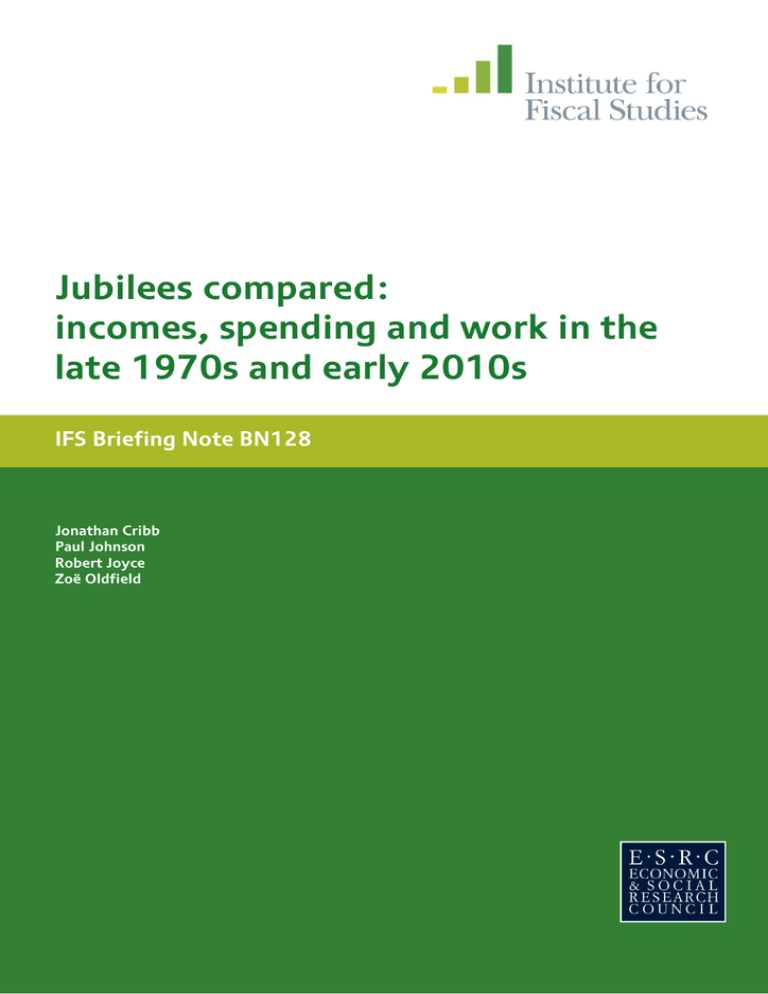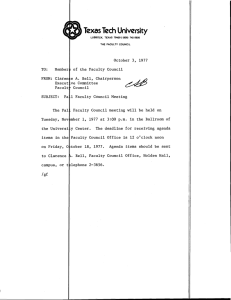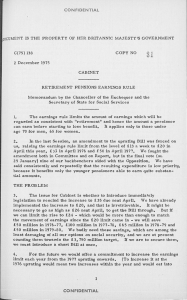Jubilees compared: incomes, spending and work in the
advertisement

Jubilees compared: incomes, spending and work in the late 1970s and early 2010s IFS Briefing Note BN128 Jonathan Cribb Paul Johnson Robert Joyce Zoë Oldfield Jubilees compared: incomes, spending and work in the late 1970s and early 2010s Jonathan Cribb, Paul Johnson, Robert Joyce and Zoë Oldfield* Institute for Fiscal Studies 1. Introduction Parallels are increasingly being drawn between current economic circumstances and those of the 1970s. You can see why. As in the 1970s, real incomes are falling, we are enduring a significant and enforced fiscal tightening and economic prospects look, at best, uncertain. In many ways, we are in worse economic straits now than we were then. National income has fallen further and is recovering more slowly than it did during the recession at the end of the 1970s. Household incomes have fallen by about 7% in real terms over the last three years for those in the middle of the distribution. We have seen nothing like that since the 1970s. Indeed, our expectation is that by 2015–16 median incomes will still be no higher than in 2002–03. Not even the 1970s had that long a period without any growth in real incomes. And of course the huge deficit, and spending cuts and tax increases to deal with it, draws inevitable comparisons with the IMF bail-out of 1976. Again, in many ways, the current situation is worse than it was back then. The deficit in 2009–10 was, relative to national income, more than 50% higher than its 1975–76 peak. And public spending is being cut much more severely. The plans are to cut spending on public services by 16% over the seven years from 2010. The worst period of the 1970s and early 1980s saw a cut of ‘only’ 9% over seven years. But these comparisons are all about changes in incomes, government spending and so on. They don’t tell us anything about levels. They most definitely are not comparisons of how well off we are. Despite the miserable economic climate, we are of course much better off in this Diamond Jubilee year than we were back in the Silver Jubilee year of 1977. In the intervening 35 years, despite recent economic woes, household incomes have more than doubled. The work we do, the goods we own, how we spend our money, and how government spends our money, have changed almost beyond recognition. * The authors are grateful for funding from the ESRC through the Centre for the Microeconomic Analysis of Public Policy at IFS (grant number RES-544-28-0001). 1 © Institute for Fiscal Studies, 2012 So in this Briefing Note we take the opportunity to reflect on a few of the ways in which economic life has changed since the Silver Jubilee year. We start by comparing incomes now with incomes in 1977. We then look, perhaps rather more revealingly, at how we spend those incomes and what sorts of things we own. Finally, we look in a bit more detail at the labour market – the types of jobs we have and the levels of education among the workforce. Many of us can remember 1977. Perhaps we are less aware of quite how dramatically our lives have changed in the last 35 years. 2. Incomes The most important fact about how household incomes have changed is that, on average, they slightly more than doubled between 1977 and 2009– 10 (the latest year for which comparable data are available). In monetary terms, we are twice as well off now as we were just 35 years ago.1 That increase in prosperity has been shared by all types of families – pensioners, working-age people with children and the working-age childless – as shown in Table 1, which compares the incomes of different family types in these years. Table 1. Average net weekly incomes (in 2009–10 prices) for example family types in Great Britain between 1977 and 2009–10 Single pensioners Pensioner couples Workingage single people without children Workingage couples without children Lone parents with one child Couples with two children 1977 £180 £239 £405 £380 £281 £363 level 2009–10 £295 £522 £574 £740 £382 £781 level Growth 64% 119% 42% 95% 36% 115% Average annual 1.5% 2.5% 1.1% 2.1% 1.0% 2.4% growth Notes: Only dependent children are counted as children. Incomes are measured net of taxes paid, inclusive of benefits and tax credits, and before housing costs have been deducted. Source: Authors’ calculations using 1977 Family Expenditure Survey and 2009–10 Family Resources Survey. 1 To be precise: mean, equivalised, before-housing-costs income increased by a multiple of 2.04 between 1977 and 2009–10. 2 © Institute for Fiscal Studies, 2012 The table shows that income growth over this period was particularly strong for pensioner couples and for couples with children. Both these groups have seen their incomes more than double. Those who have done least well are working-age single people – both lone parents and those without children – though even they have seen incomes rise by more than a third, equivalent to a rise of 1% each year. While this increase in incomes has been shared among all family types, it has nevertheless been accompanied by a very big increase in inequality. Up to 1977, income inequality had been on a long-term downward trend, a trend which, as it happens, turned around towards the end of the 1970s. The 1980s saw a historically unprecedented increase in inequality – an increase which has not been unwound since, despite the very substantial growth in the benefit and tax credit budget in the 2000s. There are numerous ways of illustrating the way in which the gap between the rich and the poor has increased. In 1977, the person 90% of the way up the income distribution had an income 1.7 times as high as the person in the middle of the distribution and 3.0 times as high as the person just 10% of the way up the distribution. By 2009–10, this person at the 90th percentile had an income more than twice the median and more than four times as high as the person at the 10th percentile. The figures for those at the very top are even more dramatic. The income share of the richest 1% has nearly trebled. Even after tax, the richest 1% of households took home nearly 9% of all income in 2009–10 compared with 3% in 1977. In terms of incomes, then, we are very much better off than we were a generation ago. And all family types have shared in that increased prosperity, with married pensioners in fact enjoying the biggest proportionate increases in their incomes. But, at the same time, income inequality has increased dramatically. The gap between the rich and the poor is very much greater now than it was at the end of the 1970s. 3. Spending and ownership of durables Like incomes, total household expenditure has risen. But in this section we are not going to look at how much people spend, rather at how they choose to spend what they have. This can reveal a great deal about changing living standards. When we are poor, a greater proportion of our spending tends to go on necessities such as food. When we are richer, we will spend more on food in absolute terms, but a smaller proportion of our total outlays will go on necessities and a greater proportion will go on luxuries. 3 © Institute for Fiscal Studies, 2012 Change is also revealed in the details of what we buy. There are many specific goods and services that we bought in the 1970s that are no longer part of our shopping basket. When the Office for National Statistics (ONS) was constructing inflation statistics in 1977, it included cine film, radio licences, party containers of beer, luncheon meat, condensed milk, lard and carpet tiles in the basket of goods whose prices it measured. These have all gone, replaced by, among much else, mobile phones, hair straighteners, low-alcohol lager, chicken nuggets, organic fruit and vegetables, and hardwood flooring. Table 2 breaks total household spending down into 14 broad categories and shows how the shares of each category in total spending have changed over time for all households, and then for those below and above state pension age (SPA). Table 2. Share of spending on various goods and services, 1977 and 2010 (percentages) All Below SPA At or above SPA 1977 2010 1977 2010 1977 2010 Food 25 15 23 13 31 18 Catering 4 5 4 5 2 4 Alcohol 5 3 5 3 3 3 Tobacco 4 2 4 2 3 1 Housing 14 21 13 22 16 18 Fuel & light 8 6 7 5 12 9 Household goods 6 7 7 7 5 7 Household services 3 6 3 6 4 7 Clothes & shoes 7 4 8 5 6 3 Personal goods & services 2 4 2 3 3 4 Motoring 9 12 11 13 5 10 Fares & public transport 3 3 3 3 2 2 Leisure goods 5 4 5 3 4 4 Leisure services 5 10 5 10 5 9 Source: Authors’ calculations based on the 1977 Family Expenditure Survey and 2010 Living Costs and Food Survey. Data are weighted. The biggest change has been in the importance of food in household budgets. In the late 1970s, one pound in every four spent, and nearly one pound in every three for pensioners, went on food. That is now down to less than 13% for those of working age and 18% for pensioners. This is one measure of how much better off the population as a whole, and the pensioner population in particular, has become. Alcohol and, especially, tobacco have also become less important elements of household budgets. As the prevalence of smoking has declined, the percentage of households spending money on tobacco has fallen 4 © Institute for Fiscal Studies, 2012 dramatically from 60% to 24%. But spending on personal goods and services, motoring, and leisure services has grown. Car ownership is much more widespread, and we devote much more of our hard-earned income to holidays and going out than we ever used to. Spending on housing has also grown substantially. The extent of car ownership is illustrated in Table 3 along with ownership of a range of other consumer durables. Perhaps as much as any statistics, these illustrate the changes in the way we live. Computers, internet connection, DVD players and so on were simply not available in the 1970s and are now in the large majority of homes. And ownership of cars, washing machines and central heating was at much lower levels than is the case today. Increases have been particularly dramatic among pensioner households. Table 3. Durables ownership, 1977 and 2010 All Below SPA At or above SPA 1977 2010 1977 2010 1977 2010 One or more cars 56% 75% 68% 79% 27% 64% Two or more cars 11% 30% 14% 37% 2% 12% Washing machine 74% 96% 80% 98% 56% 93% Central heating 50% 96% 55% 96% 38% 96% Personal computer 77% 89% 49% Television 96% 98% 96% 98% 94% 99% Dishwasher 40% 44% 32% CD player 83% 84% 80% DVD player 88% 92% 79% Internet connection 73% 85% 44% Source: Authors’ calculations based on the 1977 Family Expenditure Survey and 2010 Living Costs and Food Survey. Data are weighted. - indicates not recorded. 4. Work and education The changes in our lives at home are well illustrated by changing income levels and changing decisions about how we spend that income. Changes in our lives at work are probably best illustrated by the types of jobs we do and, importantly, by who is in work. Of course, one major change since the 1970s has been the increased participation in work of women. In 1977, fewer than 60% of women aged between 25 and 54 were in paid employment. As shown in Table 4, this had risen to 74% by 2011. There has also been a big increase in employment rates among older women. 5 © Institute for Fiscal Studies, 2012 Table 4. Employment rates by age and sex, 1977 and 2011 Male Female Age group 1977 2011 1977 2011 16–19 58% 28% 51% 33% 20–24 84% 62% 62% 60% 25–54 93% 86% 59% 74% 55–64 81% 63% 39% 48% 65 and older 13% 7% 4% 3% Source: Authors’ calculations using the Labour Force Survey, 1977 and 2011 (all quarters). The picture for men is quite different. The proportion in work has fallen at all ages but particularly among older and younger men. At older ages, a combination of early retirement and leaving the labour market for reasons of sickness or disability has seen a big reduction in the proportion of men between 55 and 64 who remain in work. Whilst this proportion has been recovering somewhat in recent years, it remains one of the great challenges of economic and social policy that unprecedented increases in longevity have been accompanied by earlier labour market exit. At the other end of the age range, changes have been equally dramatic with, particularly for men, big reductions in the proportions of those under 25 in work. These falls largely reflect increased time spent in education, as we shall see in more detail below, although the proportions of young people who are unemployed have also grown substantially. Eleven per cent of all 16- to 19-year-old women were unemployed in 2011 compared with 6% in 1977. The figures for young men are perhaps more concerning, with 17% of all 16- to 19-year-old men unemployed in 2011 compared with 7% in 1977. Overall, then, the period of working life for men has become much more compressed. They are staying longer in education; those not in education are finding the transition into work more difficult; and then those who are fortunate are retiring earlier and those less fortunate are leaving the labour market with health problems. Meanwhile, more women are spending more and more time in work. Whilst the balance between men and women in the workplace has become more equal, age diversity has fallen. At the same time, the structure of the economy since the late 1970s has changed and so people are working in quite different industries. This is illustrated in Table 5. 6 © Institute for Fiscal Studies, 2012 Table 5. Industry structure of the labour force, 1977 and 2011 Industry Agriculture, forestry & fishing Energy, mining & water Manufacturing Construction Distribution, hotels & restaurants Transport & communication Banking & finance Public admin, education, health & other services Percentage of main jobs in each industry 1977 2011 3 1 8 2 26 10 7 8 18 19 6 9 6 16 25 36 Total 100 100 Source: Authors’ calculations using the Labour Force Survey, 1977 and 2011 (all quarters). In 1977, a quarter of employees were working in manufacturing and a further 8% were in energy, mining and water. These fractions had fallen to just 10% and 2% respectively by 2011, reflecting the relative demise of these sectors. The big increases have been in banking and finance and in public administration, education, health and other services. These figures represent a dramatic change in the shape of the economy and in the type of jobs we are doing. Working in mines and factories has been replaced by working in banks and hospitals. It is worth noting, though, that three major sectors do remain just as important now as they were then: construction, transport and communication, and distribution, hotels and restaurants were each almost equally important in 1977 as they are today. Given the change in the types of firms that workers are working for, there has also been a considerable change in the occupational structure of the labour market. As Table 6 shows, the percentage of people working in professional and managerial jobs has risen from 25% to 43%. The percentage of women in such jobs has doubled from 19% to 39%. This has been accompanied by a large fall in the percentage of women in clerical and administrative jobs. There has also been a big drop in the proportions employed in manual work. This change in the structure of the labour market has itself been facilitated by, and has precipitated, a huge generational change in educational attainment. This change is illustrated in Table 7. 7 © Institute for Fiscal Studies, 2012 Table 6. Occupational structure of the labour force, 1977 and 2011 Occupational group Professional/Managerial Administrative/Clerical Sales/Customer service Other – skilled and unskilled Percentage of main jobs in each occupational group 1977 2011 Male Female Total Male Female Total 28 19 25 46 39 43 7 31 16 5 19 11 4 10 6 6 11 8 61 41 53 44 31 38 Total 100 100 100 100 100 Source: Authors’ calculations using the Labour Force Survey, 1977 and 2011 (all quarters). 100 Table 7. Educational attainment of working-age population, 1977 and 2011 (percentages) With a degree Male 5 1977 Female 2 Total 3 Male 24 2011 Female 24 Left education before 16 59 59 59 11 12 Left education at 16 19 19 19 33 30 Left education after 16 22 22 22 56 58 Note: Working-age population defined as all individuals aged 16–64 inclusive. Source: Authors’ calculations using the Labour Force Survey, 1977 and 2011 (all quarters). Total 24 12 31 57 In 2011, nearly a quarter of the working-age population – and a third of those aged 25 to 30 – were in possession of a degree. Only 3% had a degree back in the late 1970s. The change has been more dramatic for women than for men. Proportions of men and women with degrees are now the same. In 1977, only two women in a hundred were educated to degree level compared with five in a hundred men. At the same time, the advantage conferred by having a degree in terms of higher earnings has actually increased. The huge increase in the supply of graduates has been more than matched by an increase in demand. At the other end of the educational spectrum in 1977, nearly 80% of working-age people had left school at 16 or earlier, compared with just over 40% now. Since the late 1970s, in just 35 years, the British economy and labour market have undergone an extraordinary revolution. Employment has shifted dramatically away from manufacturing, mining and manual occupations towards services and towards professional and managerial occupations. Women have gained ground in the labour market whilst men, especially those over 55, are much less likely to be in work than they were. 8 © Institute for Fiscal Studies, 2012 Perhaps most remarkable is the huge expansion in education. This means that we now start work a lot later, on average, than we did and the proportion of the workforce with a higher education qualification has risen eightfold. That trend has further to go. As the expansion in higher education works its way through, we will head towards a world in which a third of the workforce is educated to degree level. Of course, there have been many other changes in the working-age population, not least a doubling in the proportion born abroad – a proportion which rose from 6% in 1977 to 12% in 2011. 5. Conclusions In an earlier publication,2 we showed how dramatically the role of the state changed between the late 1970s and the present day. Social security and health took up a third of public spending in the late 1970s; they account for a half now. Spending on housing, defence and support for industry has fallen back in proportion. The state is engaged ever more in welfare provision. Just as what the government does has changed almost beyond recognition, so has what we as citizens do. We may still be coming through the deepest recession in living memory, but we are for the most part incomparably better off than we were in the Silver Jubilee year. Incomes have doubled on average. We need devote much less of our spending to necessities such as food, leaving us free to spend more on leisure pursuits. As a nation, we are vastly better educated. We have moved decisively away from a manufacturing economy towards one based on services. Many more of us work in professional and whitecollar occupations. Women are much more established in the labour market and have made particularly substantial strides in educational attainment. Of course, not everything is rosy. While the incomes of all family types, and especially pensioners, have risen, inequality has also increased dramatically. Incomes of the rich have risen very much more quickly than incomes of the poor. Whilst some men are leaving the labour market early entirely voluntarily, many more in their 50s and 60s are now dependent on disability benefits. And the growth in the numbers of graduates leaves a minority of those with very poor levels of education struggling in the labour market. 2 R. Crawford and P. Johnson, The Changing Composition of Public Spending, IFS Briefing Note 119, 2011, http://www.ifs.org.uk/publications/5650. 9 © Institute for Fiscal Studies, 2012 Overall, though, these comparisons are a timely reminder of just how much material well-being has improved and just how different is likely to be the experience of children born to those who were themselves children in 1977. We very often focus on how things change from one year to the next. Sometimes it is worth stepping back and recognising the fruits of economic growth. 10 © Institute for Fiscal Studies, 2012


